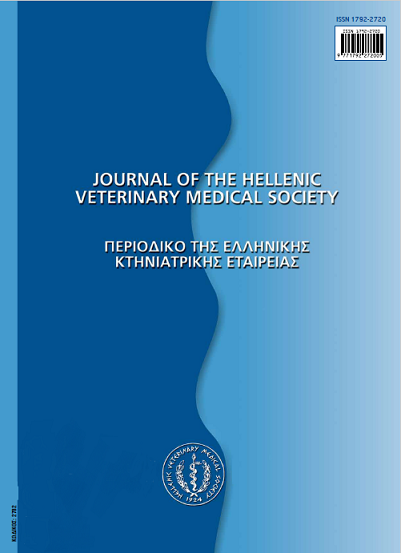Serological survey of antibodies against Toxoplasma gondii in organic sheep and goat farms in Greece
Resumen
Toxoplasmosis is a parasitic infection with global distribution caused by the protozoon Toxoplasma gondii. The present study is divided into the preliminary and the basic research. In the preliminary research, 413 serum samples (184 sheep and 229 goats) from organic farms of Péloponnèse and Western Sterea Hellas were tested for IgG antibodies against Τ gondii, by using enzyme-linked immunosorbent assay (ELISA). Blood sampling took place during spring of 2005 and samples were taken from male animals and female that had aborted during the reproductive period of 2004-2005. Significant prevalence of antibodies was the reason that further research of toxoplasmosis in organic farms was conducted. For the basic research, small ruminants' blood samples from organic farms of Péloponnèse, Western Sterea Hellas and the county of Ioannina, were collected during summer of 2006. Blood samples were collected from flocks with cases of abortions during the reproductive period of 2005-2006. Animals were separated into 3 groups: males, females that had abortions during the reproductive period of 2005-2006 and females that did not have abortions during the same period. A total number of 182 sheep sera and 167 goat sera were tested by using the enzyme-linked immunosorbent assay (ELISA). The results showed that antibodies were detected in 38.46% of male sheep, 60.87% of female sheep that had abortions during the reproductive period 2005-2006 and in 54.21% of female sheep that did not have abortions during the same period. Significant difference was determined only between male and female animals (p<0.05). In addition, antibodies were detected in 12.12% of male goats, 14.29% of female goats that had abortions and in 22.35% of female goats that did not have abortions in the reproductive period 2005-2006. There was no significant difference between the results (p>0.05). Seroprevalence in goats was significandy lower than that of the sheep (p<0.05). In animals, aged less than 4 years old, seroprevalence was significantly lower (39.58% for sheep and 13.04% for goats) than that for animals aged more than 4 years old (61.97% for sheep and 24% for goats) (p<0.05). The results of the survey suggest that there is high prevalence of toxoplasmosis both in animals that had aborted and in animals that had not aborted and that there are different species and gender susceptibility. Results also indicate that toxoplasmosis is more common in older animals.
Article Details
- Cómo citar
-
NTAFIS (Β. ΝΤΑΦΗΣ) V., XYLOURI (Ε.Μ. ΞΥΛΟΥΡΗ) E., DIAKOU (Α. ΔΙΑΚΟΥ) A., SOTIRAKOGLOU (Α. Κ. ΣΩΤΗΡΑΚΟΓΛΟΥ) K., KRITIKOS (Ι. ΚΡΗΤΙΚΟΣ) I., GEORGAKILAS (Ε. ΓΕΩΡΓΑΚΙΛΑΣ) E., & MENEGATOS (Ι. ΜΕΝΕΓΑΤΟΣ) I. (2017). Serological survey of antibodies against Toxoplasma gondii in organic sheep and goat farms in Greece. Journal of the Hellenic Veterinary Medical Society, 58(1), 22–33. https://doi.org/10.12681/jhvms.14972
- Número
- Vol. 58 Núm. 1 (2007)
- Sección
- Research Articles
Authors who publish with this journal agree to the following terms:
· Authors retain copyright and grant the journal right of first publication with the work simultaneously licensed under a Creative Commons Attribution Non-Commercial License that allows others to share the work with an acknowledgement of the work's authorship and initial publication in this journal.
· Authors are able to enter into separate, additional contractual arrangements for the non-exclusive distribution of the journal's published version of the work (e.g. post it to an institutional repository or publish it in a book), with an acknowledgement of its initial publication in this journal.
· Authors are permitted and encouraged to post their work online (preferably in institutional repositories or on their website) prior to and during the submission process, as it can lead to productive exchanges, as well as earlier and greater citation of published work.








